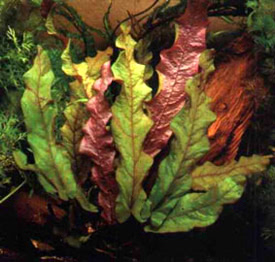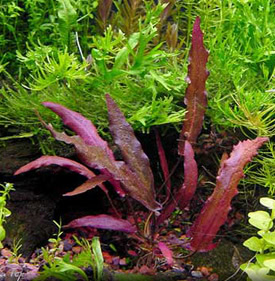
 Magyarul / Hungarian
Magyarul / Hungarian


- Scientific name: Barclaya longifolia
- Synonym: Hydrostemma longifolium
- Common name: Orchid lily
- Family: Nymphaeaceae
- Group: Aquarium plants
- Max height: 50 cm
- Distribution: Asia; Burma, Andaman Islands, southern Thailand, India, Sumatra, New Guinea
- Habitat: Grows in loose to dense populations in sunny and semishady places in rapid-flowing, predominantly clear streams carrying soft, acid water.
- Substrate: Nutrient-rich substrate (clay additive)
- Placement in aquarium: Background, Middleground
- Lighting needs: Bright
- Temperature: 25-30°C
- pH: 6,8-7,2
- Hardness: 4-6NK°
Description: This attractive plant has long, wavy leaves with a reddish underside and olive-green topside, although the colors do vary across the leaf. The plant is demanding and requires soft water with plenty of nutrients, both in the substrate and in the water. High oxygen levels may cause it to deteriorate quickly. However, if it is properly cared for, it can become a very fine display specimen for the midground or background of smaller aquariums.
A magnificent and demanding but recommendable aquarium plant which is best maintained in soft to medium-hard, acid water at temperatures of 25-28 °C. Also recommended is a nutrient-rich substrate (clay additive). Light is less important, but the plants must not be placed in too dark location. The tender leaves are a welcome food for snails, so care must be taken. After a period of good growth and ample flowering, Barclaya will usually retreat in development, but will grow again after a few weeks. Under good cultivation conditions a plant may survive several of such periods; new plants should nevertheless again be reared from seeds. If a lower, slower growth is desired in aquariums, it is recommended to set the plants into pots which are then inserted into the substrate. Growth will then proceed much slower and the plants will remain small for a longer period. Large specimens of Barclaya longifolia can be used as solitary plants; smaller plants can temporarily be terraced as a grouping. Sexual propagation using seeds is very productive. Flowers will often develop under water in aquariums and will rarely open, but will nevertheless produce seeds (cleistogamy). After a maturing period of about seven weeks, the fruit will rot away and release the seed. It should be left to germinate under a lot of light because, under such conditions, the germination quota will usually be very high. The young plants are reared in a low-set aquarium under good lighting conditions. Initially they will grow quickly, but often a cessation in growth will occur after a couple of weeks. This difficult phase can best be bridged if the plants are then transferred. Barclaya longifolia generally handles the transfer well and often subsequently "rewards" the change in environment with even further improved growth. A transfer should, however, not take place during the resting period. The plants will be ready to flower again after only 1 year. The rare, green-colored form can also develop excellently in the aquarium. It remains a little smaller, however.






